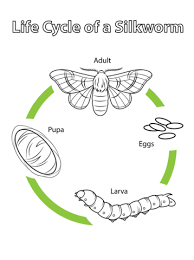Lifecycle of silkworm is a very interesting thing to study. Lifecycle of a silkworm mainly consists of five stages. But before looking into the lifecycle, let us know about silkworm itself.
Silkworm is the larva or caterpillar of a silk moth. A domestic silk moth is an insect from the moth family Bombicidae. It is known as Bombyx mori. The wild silk moth, Bombyx Mandarina, is its closest relative. Wild silk moths are not as commercially viable for producing silk, compared to domestic silk moths. Domestic silk moths are domesticated from wild silk moths.
Silkworms are used to produce silk and that is one of the reasons behind the interest. Silk is one of the most commonly seen fibers in the clothing market. It is a natural fiber that is produced from silkworms. Silkworm is reared to obtain silk.
Index
Lifecycle of a Silkworm Explained
The lifecycle of a silkworm ranges from 6 to 8 weeks. This lifecycle is also based on the weather; if the weather is warmer, the silkworm completes its lifecycle quickly, and if it is cold, it takes more time.
The lifecycle also depends on other factors such as humidity, exposure to sunlight, etc. Silkworms ideally experience 12 hours of sunlight, and 12 hours of darkness per day, 23-28℃ temperature and humidity levels of 85-90%.

The following stages show the lifecycle of a silkworm:
- Stage 1: Egg
The first stage in the lifecycle is an egg. A female moth lies the egg, generally in the size of small dots. More than 350 eggs are laid at a time. These eggs hatch in the springtime, which happens once a year.
- Stage 2: Silkworm Larva
After these eggs crack, silkworm larvae come out. The larva grows in this stage, by feeding on a large number of mulberry leaves for around 30 days. The maximum growth of each larva takes place in this stage.
- Stage 3: Cocoon
Silkworms tend to turn translucent and yellow in color, in this stage. They begin to spin protective cocoons around themselves in this stage. These cocoons are the size of a small cotton ball. The approximate time that is needed for the entire cocoon to be developed is just 2 days.
- Stage 4: Pupa
This is a stage wherein there is no movement in the silkworm. It is kind of a dormant state.
- Stage 5: Moth
The pupa transforms into an adult moth in this stage. If its a female moth, it again lays eggs after mating and the lifecycle goes on again.
Process of Obtaining Silk
As silkworms’ cocoons are used in silk extraction, we should discuss that process as well. The process goes as follows
- The rearing of silk is known as sericulture. In this process, silkworms are cultivated.
- They are fed with mulberry leaves and after the fourth moult, they climb a twig that is placed near them and spin their cocoons.
- Silk is a continuous filament that is secreted by two salivary glands in the head of each worm, and a gum called sericin. This sericin is removed by placing the cocoons in hot water, which frees the silk filaments and readies them for reeling.
- These filaments are combined to form a thread, which is drawn under tension through several guides and wound onto reels.
- After drying, the obtained raw silk is packed based on its quality.
FAQs
The stages in the lifecycle of a silkworm are egg, larva, pupa, cocoon and finally moth.
The lifecycle of a silkworm generally ranges from 6-8 weeks depending upon weather conditions, humidity, etc.
It is the process of rearing or cultivating silkworms in order to extract silk from them.
